website design to sell products
After researching for weeks and selecting the top 10 solutions, we've tested them in the last 5 days and here are our findings: We believe that Easy Digital Downloads (EDD) continues to be the best tool for people interested in selling digital goods online. This is followed closely by SendOwl and Gumroad, both of which stand strong for selling products online, particularly in the digital goods sector.
 Blogs and online stores often require the functionality to sell digital goods online. This demands an entirely different software that's simpler and accommodating for sending links to customers with the digital content downloads.
Blogs and online stores often require the functionality to sell digital goods online. This demands an entirely different software that's simpler and accommodating for sending links to customers with the digital content downloads.
Compared to physical products, these digital items aren't tangible in nature; therefore, you'll host them on your site and then notify the customer with some sort of file.
For example, some commonly sold digital goods include:
- eBooks
- Music tracks
- Photographs
- Exclusive podcasts
- Webinars
- Video training courses
- Software
- Web services
- Templates for things like emails and websites
- Web graphics and vectors
This decision comes from the fact that EDD remains free (besides any extensions and payment provider fees,) you can integrate it with just about any site, the reports deliver spot-on metrics for evaluating the health of your store, and the user interface makes things simple for both you and the user (products show up clean on your site, and the customer receives an instant email with a link after they purchase your digital product).
As for the other digital selling solutions, they range in purpose. For example, some of them integrate with current websites, while others are more pre-built solutions where you must pay a monthly fee for a complete online store system.
Some of the plugins and software provide support for physical items, while others don't. One of the main attributes we looked at was flexibility, AKA the overall ability to expand your site, sell on other platforms, customize your own website.
One of the main attributes we looked at was flexibility, AKA the overall ability to expand your site, sell on other platforms, customize your own website.
A Great Example: One of our recommendations is called Sellfy.
As neither our first or second recommendation, it begs the question: Why not? Sellfy serves people who don't want to spend much time with design. It's wonderful for beginners who would rather spend more time on developing new items to sell rather than working on web design. Here's our in-depth review of Sellfy.
However, Sellfy constricts you to its own community, taking full control away from you, since the sites are templates that all look similar and run through Sellfy. (Like making a storefront on Amazon).
Runner-up SendOwl opens up all sorts of possibilities in terms of selling digital goods on any CMS or website building platform. It costs more than EDD, but the pricing plans depend entirely on the number of products on your site and the amount of download storage space. Therefore, you're not going to ever spend more than you need to.
SendOwl is one of the easiest ways to sell your digital products. It's primarily designed for selling digital items, so they give you simple buttons to put anywhere and you can upload a wide variety of product files. The no-popup, no-installation shopping cart appears tidy and minimal. You also get some powerful tools such as discount management, shipping and tax calculations, simple payment processors, variable product options and more.
As for why it's in second place, the interface for EDD beats out that of SendOwl, and EDD has a wonderful extension library. Although SendOwl has a massive set of built-in features, you're stuck with whatever they give you. Therefore, minimal integrations. Furthermore, EDD is free (without any extensions).
Table of Contents
- Why You Should Trust Us
- Who is This For?
- How I Chose and Tested Ways to Sell Digital Goods Online
- Our Pick for Selling Digital Goods: Easy Digital Downloads
- The Runner-up: E-Junkie
- How the Competitors Compare
- Some Final Thoughts and Things to Remember
Why You Should Trust Us
I started my career in marketing and web design, but as time went on, I started doing reviews, roundups, and tutorials for Ecommerce Platforms, giving me an inside look into the industry. At that point, I had published and sold mainly digital products online (such as marketing webinars and instructional eBooks for freelance writers). Therefore, my research led me to test out solutions like WooCommerce, Easy Digital Downloads and Shopify.
The majority of my digital books and video sales went through a WordPress site, but that was mainly because I had attached the store onto my blog after starting the blog about three years prior.
Selling my own services and digital goods online got me started in the business, but Ecommerce Platforms has launched me into a world where I'm thinking about selling online all the time.
For example, I have meticulously tested the top ecommerce platforms online for two weeks and compared them for things like pricing, payment gateways, templates, support and marketing tools. I understand the intricacies of payment processors and what merchants should look for to keep costs low.
Not only that, but I've learned the skills to construct online marketplaces and more complex online stores where thousands of merchants sell products.
Overall, the folks at Ecommerce Platforms and I have a lot of experience when it comes to ecommerce website design, payment gateway versatility, app integrations, customer support quality and shopping cart ease of use. Since the Ecommerce Platforms site receives thousands of views and comments per month, we're blessed with user feedback on all of our reviews. Therefore, many of the opinions are formed based on what other people have to say.
Finally, I've been known to put together comprehensive comparisons of platforms for selling both physical and digital goods, like my comparison of the top ten ecommerce platforms of all time. These comparisons take lots of time, effort and money–things that most people don't want to spend when looking for a single platform. Therefore, I've done the work and digested the information for presenting it in easy to read formats for my readers.
Who is This For?
Everyone could potentially sell digital products online at some point. A hardware store could put together a video training program for how to maintain a new home after buying. A web design blogger could put together a stunning eBook for selling to developers and designers all over the world. A physical goods ecommerce store could realize that they could make more money by selling digital add-ons (Like a clothing shop that sells style guides or videos for reselling your own clothes).
A web design blogger could put together a stunning eBook for selling to developers and designers all over the world. A physical goods ecommerce store could realize that they could make more money by selling digital add-ons (Like a clothing shop that sells style guides or videos for reselling your own clothes).
Keep in mind that digital selling platforms also do the trick when you're trying to give away digital items. Let's take that hypothetical clothing shop, for example. A fall style guide might work better as an incentive for people to buy from your shop. Therefore, you can give it away for free when someone purchases a shirt or pair of pants. With tools like EDD and SendOwl, you can automatically send the files to customers without
A fall style guide might work better as an incentive for people to buy from your shop. Therefore, you can give it away for free when someone purchases a shirt or pair of pants. With tools like EDD and SendOwl, you can automatically send the files to customers without charging.
We also recommend this guide to folks who want to break a window whenever they see a bill from their current digital selling platform. The same goes for those who think their user interface is too hard to work with.
Our recommendations take into consideration both user experience and cost. That's why EDD is way at the top with no cost at all, and SendOwl suits those who would rather a monthly fee rate instead of some percentage or transaction fee.
If you're new to the digital selling game, this article is your guide to finding the ideal product. If you currently have a way to peddle your digital goods, and you're satisfied with the design tools and the pricing you pay, you're better off sticking with what you have instead of going through a transition process.
How I Chose and Tested Ways to Sell Digital Goods Online
Now that I've discussed the reasons for choosing a digital selling platform, along with who should consider one of these systems, we can look at the top ten tools for doing so:
- Easy Digital Downloads
- SendOwl
- Gumroad
- Sellfy
- E-Junkie
- WooCommerce
- Shopify and the Digital Downloads App
- Pulley
- DPD
- FetchApp
When evaluating all of the tools above, I put all of them on an even playing field from the start. No bias was had towards any of them, so I began looking at the features I feel are most important in a platform that helps with selling digital products.
Although these are the more obvious tools, I decided on three must-have features to start narrowing down the field. I also looked at the user-friendliness of the features from each platform, therefore eliminating a few for the top recommendation from the start.
The three must-have features are:
- Powerful digital storage and delivery – This is an interesting one because many tools don't provide an unlimited amount of storage for your digital files. When discussing powerful file delivery, it's more about automation and simplicity. The goal here is that the system automatically sends out an email with a link right after the user makes a purchase. In addition, we want some customization tools for those emails or download pages. The main area that's going to separate candidates is how easy it is to store files, since you may end up running out of space with a self-hosted platform.
- A clean shopping cart – I understand that this is somewhat subjective, but I figure that most people can click through the shopping cart and reasonably decide whether or not they feel it delivers a clear, short path to making a purchase. This includes a minimal amount of steps in the checkout process, seeing as how no one wants to click five buttons just to make a purchase. In addition, I don't want any type of branding (besides my own store) in the checkout lane. I also like the idea of having no popups, minimal distractions, plenty of white space and forms that clearly describe what needs to be filled in. Along with that, it's nice to have a guest checkout option and shopping cart/checkout that remains on your website instead of being redirected somewhere else.
- Integrations with the top payment gateways – Although a digital selling platform that connects with only Stripe or PayPal should do the trick, some companies don't want to use those options because of pricing or geographical restrictions. Therefore, I find it important for the tools to support all of the most popular payment gateways such as PayPal, Stripe, 2Checkout, Authorize.net and more. This provides more options for selling and puts research power in the hands of the merchant.
So, after looking at these three must-have features, which of the systems are still in the running?
- Easy Digital Downloads
- SendOwl
- WooCommerce
- E-Junkie
- Shopify and the Digital Downloads App
- DPD
- FetchApp
Dropped out:
- Sellfy – The payment gateway options are limited. You only have access to PayPal Standard, PayPal Express, and Stripe. In addition, the PayPal checkout is far from ideal, giving Sellfy a few dings right off the bat. Keep in mind, however, that Sellfy is one of the best options for inserting the shopping cart on all types of websites. Most of the features covered below are included with Sellfy, so it's most definitely not the least impressive of the bunch.
- Gumroad – Although the checkout looks beautiful and the storage stands strong, Gumroad only offers PayPal for accepting credit cards. That said, we'll talk about which niche merchants should consider Gumroad a little lower in the article.
Now that we've looked at the core features, it's time to evaluate which of them really shine in terms of add-ons, marketing potential and interesting little tools that make the systems work for just about any website.
The following features focus on flexibility and control, seeing as how I would prefer being able to expand my website as I please, and it would be nice to have complete control instead of being stuck on a platform that's limited in terms of design and functionality.
Some of the following features have more importance over others, but overall, I looked into each one, saw if the tool or feature was offered through each platform, then made a final decision as to which has the most promising arsenal for all types of digital online sellers.
Therefore, the other features I checked out include:
- The ability to integrate with any website – The ability to take a digital selling tool and implement it on any existing site comes in huge for the number of merchants who can use a platform. If you need to signup for a completely new account, it hinders those who already have pre-existing websites they would like to turn into online stores.
- A store for add-ons or extensions – Additional apps come in all shapes and sizes, but the main objective is to have an extra area to expand the power of your online store. This way you aren't stuck with a website that doesn't accept commissions or more obscure payment processors. For example, you may want to integrate with MailChimp or sell some of your digital goods for free. These tasks often come easy with the help of add-ons, apps, and extensions.
- Advanced user capabilities (wishlists, saving a cart, making a profile) – You'll notice the power of an app store as we walk through these features since many of these features can be included with the help of an add-on. That said, just because you're making a simple digital goods site doesn't mean your customer shouldn't have complete control over a profile. In fact, it's quite the opposite, because your buyers may need to download their files later on. Therefore, it's essential to provide a profile they can login to for finding their recently previously purchased files. Wishlists, cart savings and other things of this nature are bonuses.
- Simple and intuitive customer management – Can you see which of your customers have come to your site and recently purchased items? If not, you're going to have trouble with target marketing and handling complaints. Let's say someone contacts you to say that they got charged too much money for their purchase. If you can't go back to see how much they spent, you're basically forced to reimburse them without any knowledge on your end. More importantly, understanding which customers are buying molds your future marketing and sales strategies.
- Discount codes and promotions – Discounts come in all shapes and sizes in the ecommerce world. With digital selling, it's not very different. Chances are you'll want to market promotions throughout the year, especially when the holidays roll around. Since you've most likely paid for all the costs of a digital product during the creation process, discounts are essential for drumming up the business without putting yourself in the red. Some promotional tools include discounts with defined conditions, rules for how many discounts one person can use, digital discount codes to punch in, and timed promotions that expire after a certain amount of time.
- Advanced reporting – Reports strengthen your knowledge of what's going on with your store, but they also need to be simple and intuitive. My favorite reports and analytics come from Easy Digital Downloads, so that serves as the benchmark when comparing other platforms. Some things to look for include your total earnings based on date range and categories. You also want filters on your reports, taxes, exportable data, and graphs that monitor the number of downloads and sales.
- API access – Providing access to an API is huge for some users. However, others won't ever think about it. I didn't put much weight on an available API, but I realize that more advanced users are going to at least understand which of the options are open for integrating and developing external apps.
- File access control – Maintaining control of your downloads prevents stealing and sharing, while also prompting users to come back to your store for new digital downloads. Overall, file access control lets you configure expiration dates for downloads that people buy, along with download limits so that each user can't download the file multiple times and share with friends. Essentially, the file access control prevents unauthorized access of your digital content.
- Marketing tools (like email marketing and affiliates) – Most of the time you can find apps online for filling in the gaps with marketing tools (like adding MailChimp to your website). However, most people would agree that integrated marketing options make life easier for the online business person. For example, a promising marketing tactic involves social media sharing buttons and a store on your Facebook page.
- Calculators for Shipping and Taxes – Calculators reinforce trust between you and the buyer since users are known to abandon carts if you fail to reveal shipping or tax costs towards the beginning of the checkout process.
- Variable product options – Most vendors only think of product variants when selling physical items. Nevertheless, digital products may have some variants as well. For example, you may be selling multiple packages for your online video training course. If that's the case, you can implement product variables for quick dropdowns and choosing.
- Sell Subscriptions and Memberships – Subscriptions and memberships collect recurring payments. Not all digital selling platforms are created equal in this realm. In fact, some of the systems are mainly suitable if you're having a membership or subscription site. This includes content dripping as well, or the slow distribution of your content to users who pay for a membership. For example, you might not want to reveal all of the content up front from an online course. Therefore, the content drip only gives people some of the course material until they complete each section.
Our Pick for Selling Digital Goods: Easy Digital Downloads
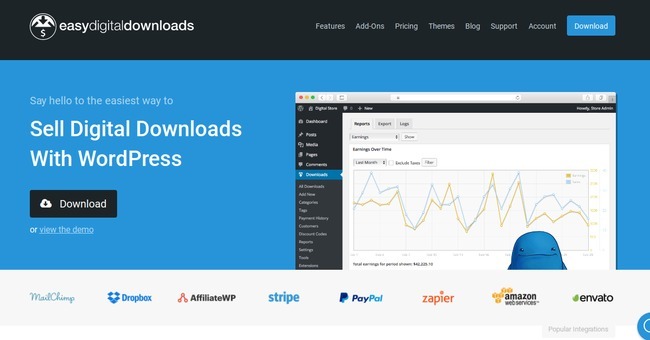
After evaluating each of the features above, Easy Digital Downloads came out above all the rest. That's not to say that others aren't useful for different situations, but overall, EDD has the best features, cleanest frontend interface, an onslaught of cool features and just about any type of business can use it for selling digital content.
It's also prudent to take a look at the pricing, which serves as another reason for our choice of EDD. This is the way I see it: EDD can be downloaded for free, but webmasters often end up spending money on the add-ons, many of which are pretty much required for a complete ecommerce store.
For example, the Stripe Payment Gateway is $49 and MailChimp goes for $29. Overall, you're not required to spend money for the basic selling of digital goods. In fact, most simple stores will only end up paying for hosting and installing both WordPress and EDD for free. But keep in mind that additional costs may loom depending on how advanced you would like to make your site.
Continue reading to view how EDD held up with each of my more important features:
- The ability to integrate with any website –EDD has one of the most intuitive interfaces, especially when it comes to installing on your website. One of the primary reasons you might skip EDD is because it only integrates with WordPress. For many people, this is a good thing (WordPress is pretty easy to learn, and many people already use it). But others may not want to go through this training, or their current site may not be located on WordPress.
- A store for add-ons or extensions – EDD offers an impressive store, but you'll have to pay for the advanced tools. That said, you gain access to options for subscriptions, frontend submissions, payment gateways, bookings, reviews, commissions and more.
- Advanced user capabilities (wishlists, saving a cart, making a profile) – Both user and guest checkouts come along with EDD, and users can save their carts while shopping. They can also make simple profiles for saving their carts and coming back later. Overall, the profiles are basic, with nothing too confusing for the user. From my testing, a user can't generate a wishlist, and there's no extension to make this happen.
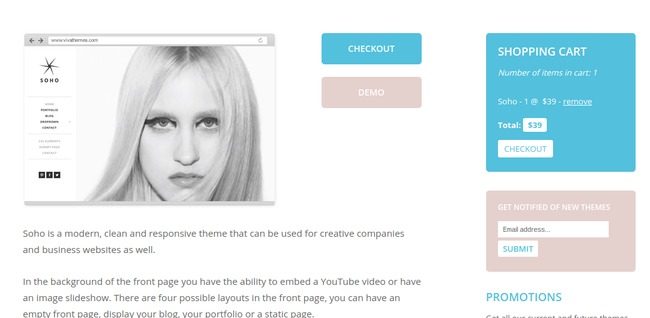
- Simple and intuitive customer management – Keep track of all your customers separately. You can go in there and download a full list, or click through to see what John Doe has been up to on your site. Editing and deleting customers is allowed, and you can generate a report for customer lifetime value, allowing you to put more focus on the people who spend more money.
- Discount codes and promotions – Discount codes are built right into the system, so it allows for flat rate or percentage based discounts. Some products can be excluded, and the start and end dates are managed on the dashboard. EDD even has a module for specifying a minimum required cart total for a discount code to work. For example, you might offer a little discount after someone puts $100 worth of digital downloads in their cart.
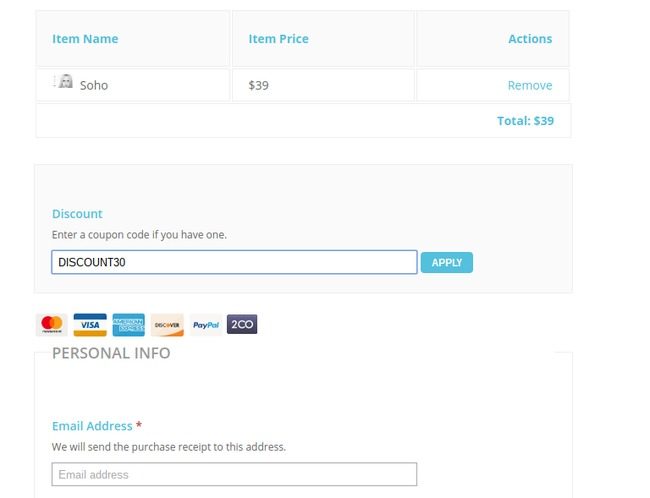
- Advanced reporting – Reporting has its own tab under the Digital Downloads area of WordPress. I've come to appreciate these simplistic reports, with the main area focusing on earning for a certain time period. All the essentials are included with the reports, such as exporting data, monitoring downloads, tax tracking and some filters for making your own reports based on specific products.

- API access – Sales and product information is given in JSON or XML format. Developers have complete API access for expanding on the EDD platform, while also integrating with certain applications.
- File access control – It seems like everyone steals digital content, from music to eBooks. You can't do much about it, but there are some ways to block it as best you can. EDD has file access control activated by default, so the only people who can download the files are the people who bought the files. In addition, you can set a file download limit to prevent an insane number of downloads from one person.
- Marketing tools (like email marketing and affiliates) – Connecting your favorite email marketing tool requires an extension. As for affiliates, you pretty much have one choice: Affiliate WP. This works right out of the box, but you can also try out some other affiliate WordPress plugins if you'd rather not pay a fee.
- Calculators for Shipping and Taxes – Both of these are calculated if needed. I figure you'll mainly be selling digital products that don't need shipping, but the Simple Shipping extension supports the shipping of smaller, basic packages.
- Variable product options and prices – The Variable Pricing Switcher serves as the main extension for this. Judging by my research there's no solution built-into the product.
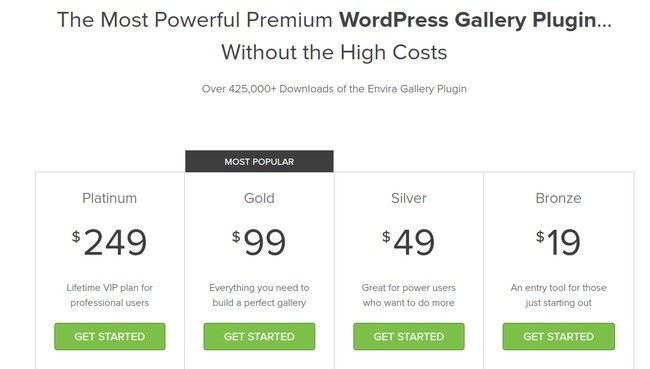
- Sell Subscriptions and Memberships – It took me a moment to realize that membership and subscription functionality is in EDD, but I eventually located it under the extensions. Therefore, you'll have to pay for Recurring Payments, and potentially the Restrict Content Pro Member Discounts extension. I would recommend combining the two if you're thinking about hiding some of your content (like a video course) while also collecting monthly or weekly payments.
The Runner-up: SendOwl

I like SendOwl as a more minimal option, seeing as how you don't need to know anything about WordPress, yet it still provides powerful tools for getting your digital products online and selling them to customers. In fact, the main reason I enjoy SendOwl is that it's a solution for complete beginners.
Let's see what kept SendOwl from the top spot (along with some of its advantages):
- The ability to integrate with any website –Here's one of the main reasons SendOwl stands out compared to the other competitors. It's also why it's a nice alternative to EDD. SendOwl works on the majority of websites, so you can either have an existing site or create a new one. For example, you might want to implement it on a WordPress or Shopify site. It's mainly about installing a bit of code, so you shouldn't have problems with most content management systems or ecommerce platforms.
- A store for add-ons or extensions – SendOwl lacks an app store, but it seems like the company tries to include most of the needed features in the actual platform.
- Advanced user capabilities (wishlists, saving a cart, making a profile) – Along with a beautiful responsive checkout, SendOwl offers options for saving carts and for customers to come back to check out. It's mainly managed without the user knowing, so I was a little confused since I couldn't find a shopping cart icon with a product count. There's not really a wishlist, but if you add a product to the cart, then add another one, they will both be sitting there when you checkout.
- Simple and intuitive customer management – Customer management is a little watered down compared to that of EDD, but you still get to maintain a list of people who purchase from you. The true customer management comes into play when you implement the membership feature.
- Discount codes and promotions – The discount codes can be limited to a certain time period, product or amount spent, and you can go in there and track which of the codes are doing well. My favorite part is that the discount codes can be used to target individuals or groups of customers depending on how they shop.
- Advanced reporting – There's not much to say about the reporting, except that it gives you the numbers you need. The reports are fairly advanced, so you can test which products sell and which do not. In addition, you get some metrics for your affiliate program.
- API access – All developers have access to the API for integrating with different systems and potentially making the backend more powerful for your organization.
- File access control – This is where SendOwl truly stands out. File access tools range from limited download counts to content restrictions for memberships and subscriptions.
- Marketing tools (like email marketing and affiliates) – The affiliate program is built-in, so there's no need to go out and find a plugin. The administrative tasks, reporting, and commissions are all handled by SendOwl, so your main objective is to find new affiliates. Oh yeah, and you can integrate with services like MailChimp.
- Calculators for Shipping and Taxes – Physical products are allowed, but the shipping options are a little weak. A tax calculator is provided for automatically showing taxes for the customer.
- Variable product options and prices – This is all run through custom checkout fields. Basically, you can add an additional field that asks what version of the product they would like.
- Sell Subscriptions and Memberships – Along with impressive subscriptions and membership, SendOwl has drip functionality to share some of your content for free and giving a little bit more as people pay or progress through a program. As an example, you may want to deliver extra courses as someone moves through a training program.
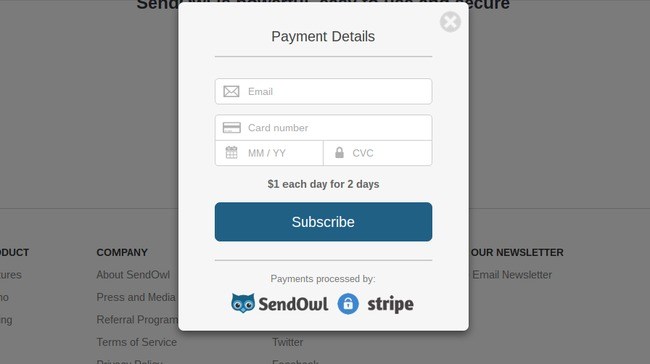
How the Competitors Compare
Let's take another look at our list of digital selling solutions:
- Easy Digital Downloads
- SendOwl
- Gumroad
- Sellfy
- E-Junkie
- WooCommerce
- Shopify and the Digital Downloads App
- Pulley
- DPD
- FetchApp
The Top Pick
We've found that Easy Digital Downloads is the most useful in terms of setting up and scaling up after you'd made progress with your store.
Our Pick for Simplicity and People Who Don't Want/Like WordPress
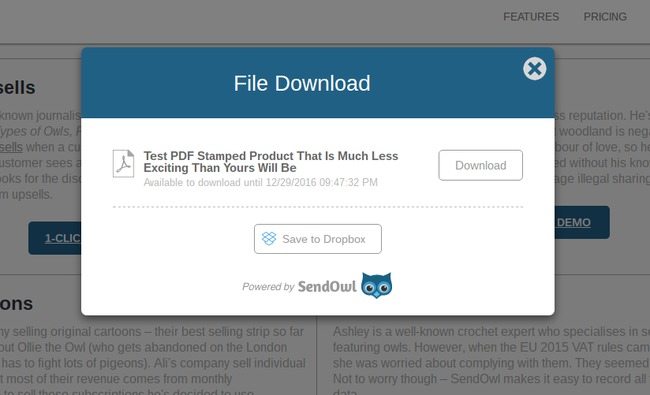
SendOwl has most of the required features, but it lacks some items like more powerful variable product controls and shipping calculators. However, I would recommend it for a company that skips EDD because it doesn't have a site on WordPress, or the new webmaster is not fond of WordPress.
E-Junkie is also a nice way to get a digital store on your website without the need to work with WordPress. I'm not all that fond of the backend interface (it looks outdated and clunky,) but the pricing is right and you get tools for subscriptions, marketing and much more.
Our Pick for Creatives Like Artists and Writers
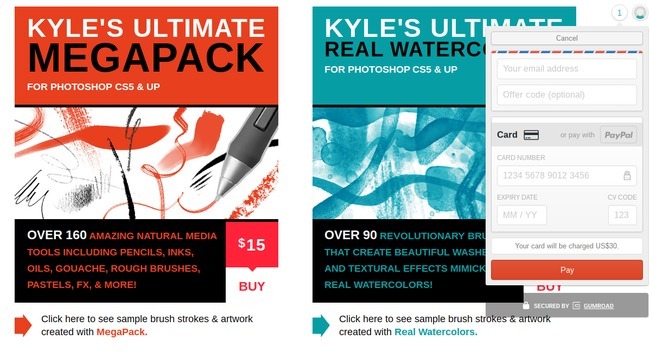
Gumroad is a service built around the idea that creatives should be spending more time generating new content like books and art. Keep in mind that since Gumroad takes over most of the work for you, it will cost you per product sold. The pricing starts at $10 per month, but then you also must pay 3.5% + 30¢ per sale. That's a large portion, especially if your products aren't priced that high. But the whole point is to help out those who don't want to spend much time on development and selling.
Sellfy is an alternative to Gumroad, but it functions as more of a marketplace like Etsy. Therefore, you construct a site through Sellfy (it's insanely easy,) but the pages all have similar branding, taking away from your own control. (Update: The Sellfy team now offers the ability to customize stores with a WYSIWYG editor. Users can now redesign their stores and make them match their existing brands). The transaction fees start high at 5% for the basic plan and decreases as you choose the Prop and Pro Plus plans. You can work up zero transactions fee if you'd rather pay $99 per month.
Our Pick for No Transaction Fees
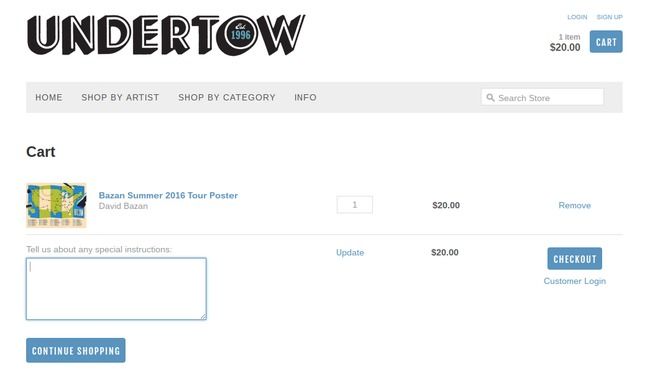
In terms of pricing and saving money on transaction fees, the Pulley solution stands out. You don't have to pay any transaction fees, except for what PayPal charges, and it's a simple option for artists of all shapes and sizes. The plans start at $6 per month (selling 25 products). The backend tools are more watered down than Sellfy and Gumroad, but sometimes that's all you need. For example, you still get things like buttons for selling on social media, automated delivery, download history, customizable emails and an integration with BigCartel.
Our Pick for Those With Lots of Physical Products to Sell
Sometimes you're going to have a store with both physical and digital goods. For most smaller stores, you can go with EDD or SendOwl. If you plan on having a more significant selection of physical goods alongside your digital products, WooCommerce (or Shopify and the Digital Downloads App) offer better support. Not only are these platforms more suitable for getting a site launched quickly with shipping tools and physical product variants, but both of them are primarily used for physical products.
For example, Shopify has hundreds of themes for you to choose from, where you can then hook up a payment gateway, adjust your settings and shipping, and start selling your physical items. After that, installing the Digital Downloads app allows for whatever digital goods you'd like to have on your store. In the screenshot, you can see a site that sells both physical and digital pieces of artwork.

Our Pick For Selling on Multiple Stores
DPD doesn't have transaction fees either. So, that's a huge plus. However, the standout feature revolves around the individual dashboard for multiple stores. Therefore, if you'd like to have a music selling site, and also sell a few eBooks on another website, it all gets managed on one DPD dashboard.
The pricing seems reasonable, starting at $10 per month; and you receive some interesting tools such as physical product support, built-in shipping and tax calculations, API support, multi-lingual checkout and an upsell feature. The subscriptions are handled beautifully, and it also supports PDF stamping, which prevents people from sharing your content.
Oh yeah, and you can integrate DPD with just about any platform you can imagine. They offer customizable product widgets and buttons. This is generally easy to do, but I understand that some creative entrepreneurs would rather spend as little time with coding as possible. Therefore, it might seem somewhat intimidating for absolute beginners.
Our Pick for the Most Flexible Pricing Plan
Some of the digital selling platforms we've outlined above aren't going to cost you a dime. For example, Easy Digital Downloads is completely free. However, it's somewhat silly to assume that you're not going to spend money at all. On the other hand, the majority of the systems either take a monthly fee or they tap into the transaction fees.
FetchApp is one of those that avoids transaction fees, instead giving you a wide range of pricing plans for more flexibility while growing your store. For instance, the lowest plan is completely free, but you only gain access to 5MB of storage space. This might work out just fine for smaller stores, but many people will want to expand past that.

They have plans set at $5, $10, $20, $30, $50, $100, $150, $200, $300 and $500 per month. Each time you move up a plan you unlock a little more storage space. Therefore, you can have all the products you want, and take advantage of all of the features, while only paying more money when those products take up too much storage.
Some Final Thoughts and Things to Remember
As you can see, choosing the best way to sell digital goods online is a little less simple than one might assume. My primary recommendation is to check out Easy Digital Downloads first. You don't have to pay to download it, and it works just fine on a free WordPress site. I also like recommending solutions with free plans, like FetchApp. You're generally not going to get the expansive set of features you would find in EDD or SendOwl, but you at least get to save a little bit of money during the testing process.
The moral of the story: You can sell digital goods online with various different platforms in any niche. I would make a list of the features that mean most to you and go through the list that we covered above. This way, you might uncover that you'd like to skip the WordPress route, eliminating EDD. Or maybe you're not interested in selling any physical products (making Shopify and WooCommerce a little too complex to mess with.)
Overall, I wish you luck in selling your digital products online. It can be a rather rewarding experience, and in general, digital products take more time than money to produce. Therefore, you can spend more time developing new products as opposed to worrying about the costs of goods and things like that.
If you have any questions about the best ways to sell digital goods online, let us know in the comments section below.
Comparison

Joe Warnimont is a Chicago-based writer who focuses on eCommerce tools, WordPress, and social media. When not fishing or practicing yoga, he's collecting stamps at national parks (even though that's mainly for children). Check out Joe's portfolio to contact him and view past work.
website design to sell products
Source: https://ecommerce-platforms.com/ecommerce-selling-advice/top-10-best-ways-sell-digital-goods-online
Posted by: dudekforeemended.blogspot.com

0 Response to "website design to sell products"
Post a Comment